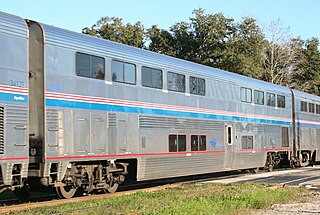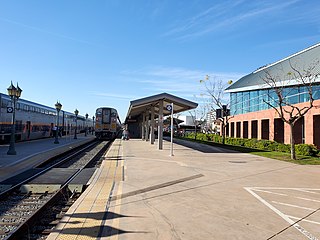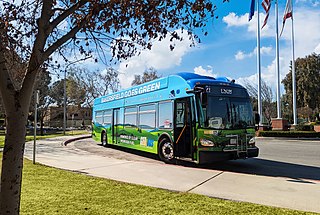Related Research Articles

A passenger railroad car or passenger car, also called a passenger carriage, passenger coach, or passenger bogie is a railroad car that is designed to carry passengers, usually giving them space to sit on train seats. The term passenger car can also be associated with a sleeping car, a baggage car, a dining car, railway post office and prisoner transport cars.

The McKeen Motor Car Company of Omaha, Nebraska, was a builder of internal combustion-engined railroad motor cars (railcars), constructing 152 between 1905 and 1917. Founded by William McKeen, the Union Pacific Railroad's Superintendent of Motive Power and Machinery, the company was essentially an offshoot of the Union Pacific and the first cars were constructed by the UP before McKeen leased shop space in the UP's Omaha Shops in Omaha, Nebraska. The UP had asked him to develop a way of running small passenger trains more economically and McKeen produced a design that was ahead of its time. Unfortunately, internal combustion engine technology was not and the McKeen cars never found a truly reliable powerplant.

The San Francisco cable car system is the world's last manually operated cable car system and an icon of the city of San Francisco. The system forms part of the intermodal urban transport network operated by the San Francisco Municipal Railway, which also includes the separate E Embarcadero and F Market & Wharves heritage streetcar lines, and the Muni Metro modern light rail system. Of the 23 cable car lines established between 1873 and 1890, only three remain : two routes from downtown near Union Square to Fisherman's Wharf, and a third route along California Street.

A Birney or Birney Safety Car is a type of streetcar that was manufactured in the United States in the 1910s and 1920s. The design was small and light and was intended to be an economical means of providing frequent service at a lower infrastructure and labor cost than conventional streetcars. Production of Birney cars lasted from 1915 until 1930, and more than 6,000 of the original, single-truck version were built. Several different manufacturers built Birney cars. The design was "the first mass-produced standard streetcar " in North America.

The TECO Line Streetcar System is a heritage streetcar transit line in Tampa, Florida, run by the Hillsborough Area Regional Transportation Authority (HART), owned by the city of Tampa, and managed by Tampa Historic Streetcar, Inc. It connects Downtown and Channelside to the historic Ybor City district. There is also an "In-Town" trolley-replica bus system that connects Downtown, Channelside, and Harbour Island.

The J. G. Brill Company manufactured streetcars, interurban coaches, motor buses, trolleybuses and railroad cars in the United States for nearly 90 years, hence the longest-lasting trolley and interurban manufacturer. At its height, Brill was the largest manufacturer of streetcars and interurban cars in the US and produced more streetcars, interurbans and gas-electric cars than any other manufacturer, building more than 45,000 streetcars alone.

The Toronto version of the Peter Witt streetcar was designed by Peter Witt, a commissioner of the Cleveland Street Railway in the United States. Between 1921 and 1923, the Toronto Transportation Commission ordered a total of 350 Peter Witt motor cars. 225 trailers would be ordered from three companies in Canada: Canada Car and Foundry of Montreal, Ottawa Car Company and Preston Car Company (Brill). The cars were designed for riders to "pay as you enter", and initially used two-person operation.

In 1920, the Toronto Civic Railways (TCR) acquired 25 single-truck, double-ended Birney streetcars from the J. G. Brill Company. In 1921, the Toronto Transportation Commission (TTC) acquired all assets of the TCR including the 25 Birney cars. In 1927, the TTC sold 3 of the Birney cars to Cornwall, Ontario and 8 to Halifax, Nova Scotia. In 1941, the remaining 14 Birney cars were sold, again going to Halifax.

The Los Angeles Railway was a system of streetcars that operated in Central Los Angeles and surrounding neighborhoods between 1895 and 1963. The system provided frequent local services which complemented the Pacific Electric "Red Car" system's largely commuter-based interurban routes. The company carried many more passengers than the Red Cars, which served a larger and sparser area of Los Angeles.

The McGuire-Cummings Manufacturing Company was a streetcar and street-railway equipment builder based in the U.S. state of Illinois. It was originally based in Chicago, but had a subsidiary factory in Paris, Illinois, and in its last years it was based in the latter city. It was founded in 1888 as the McGuire Manufacturing Company, later becoming McGuire-Cummings, and finally the Cummings Car and Coach Company. Snowplow cars and snow sweepers – street railway cars designed specifically for snow removal – were among its most popular and best-known products. The company built its last streetcars in 1930, but remained in business until 1943. McGuire-Cummings was one of a few suppliers for the Toronto Civic Railways.

Bakersfield station is an intermodal facility in Bakersfield, California. It is the southern terminus of Amtrak California's San Joaquins route, with Amtrak Thruway buses continuing to Amtrak stations and bus stops throughout Southern California and Nevada. The station opened with a celebration on July 4, 2000. It contains an 8,300-square-foot (770 m2) train station with two platforms and three tracks, as well as a 17-bay bus station.

The Pioneer III railcar was a short/medium-distance coach designed and built by the Budd Company in 1956 with an emphasis on weight savings. A single prototype was built, but declines in rail passenger traffic resulted in a lack of orders so Budd re-designed the concept as an electric multiple unit (m.u.). Six of the EMU coach design were purchased by the Pennsylvania Railroad with the intention of using them as a high-speed self-contained coach that could be used for long-distance commuter or short-distance intercity travel in the Northeast U.S. The 6 production Pioneer III units were the first all-stainless-steel-bodied EMU railcar built in North America and, at 90,000 pounds (41,000 kg), the lightest.

Golden Empire Transit is the operator of mass transportation in Bakersfield, California. There are 16 routes serving Greater Bakersfield, which includes both the City of Bakersfield and adjacent unincorporated communities. Since 2005, almost the entire bus fleet has been powered by compressed natural gas. In 2021, 5 hydrogen buses were added to the fleet, with an additional 5 planned for purchase in the future. In 2023, the system had a ridership of 3,531,400, or about 11,400 per weekday as of the third quarter of 2024.
The Bakersfield and Kern Electric Railway was a streetcar company which operated between Bakersfield and Sumner, in California. Later, after Kern City was annexed by Bakersfield, the streetcar company operated completely in Bakersfield. The company was originally formed in 1887, under the name Bakersfield and Sumner Railroad. At its height, in 1915, the company operated five streetcar lines, totaling 10.5 miles (16.9 km). It also operated three feeder bus lines, one of the first companies in the nation to offer that type of service. Also, with the exception of one-way sections, the entire system was double tracked.
The West 19th Street Line was a line of the Bakersfield and Kern Electric Railway. The route originated at the intersection of 19th Street and F Street, and traveled west on 19th Street. It would turn south on Oak Street and terminate at Truxtun Avenue. For most of its life, the line was combined with the North Chester Line. The line was constructed in 1903, as part of the original expansion plan. It closed in 1933.
The Santa Fe and Southern Pacific Line was the main line of the Bakersfield and Kern Electric Railway. It operated between the Santa Fe Bakersfield Station and the Southern Pacific Bakersfield Station. It was the first line in the system, constructed in 1888. It was also the last line to close in the system, in 1942.

Bakersfield station is a former Southern Pacific Railroad station and hotel in Bakersfield, California. The station opened June 27, 1889, in the town of Sumner. The station was a mixture of Richardsonian Romanesque, Spanish Colonial Revival, and Moderne styles. It was closed in 1971, after the formation of Amtrak.
Prior to 1959, Montreal, Quebec, Canada had an extensive streetcar system. The streetcar network had its beginnings with the horsecar era of the Montreal City Passenger Railway in 1861. The initial line was along Rue Notre Dame from Rue du Havre to Rue McGill.

The Evansville & Eastern Electric Railway was put into operation on 10 June 1906 was one of the very few electric lines in the United States which did not parallel a steam railroad.

The electric railway of the White Knob Copper Co., Ltd. was operated by the White Knob Copper Co. at White Knob near Mackay, Idaho, in connection with its mines, having 7.1 miles (11.4 km) of railroad, two electric locomotives and 40 ore cars. The difference in level over the seven miles was 2,100 feet (640 m), an average of 6 per cent. Eighty tons of ore were handled by each train.
References
- 1 2 3 4 5 6 7 8 9 10 11 12 Bergman, John (2009). The Southern San Joaquin Valley: A Railroad History. Visalia, California: Jostens Printing and Publishing Company. pp. 140–142.
- 1 2 3 4 Guido, Francis A. (1955). "Bakersfield & Kern Electric Railway". The Western Railroader. 18 (4): 7.
- ↑ "Bakersfield & Kern 4". Orange Empire Railway Museum. Archived from the original on 2011-05-14. Retrieved May 5, 2011.
- ↑ Lynch, George (March 11, 2008). "The Streetcars, Gone but not Forgotten". The Bakersfield Californian. Archived from the original on 2011-07-07. Retrieved May 5, 2011.